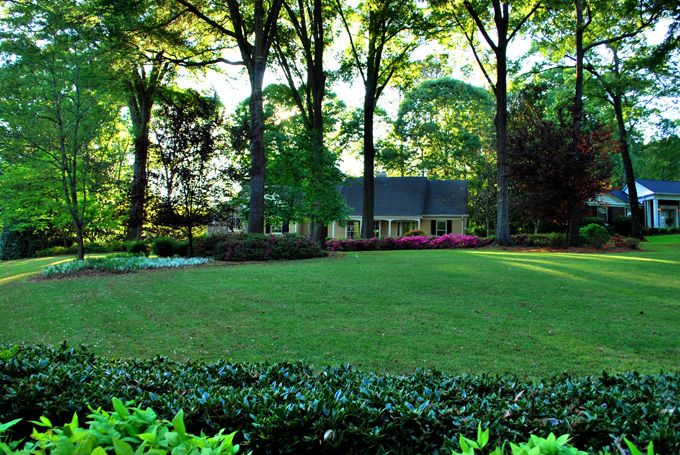
Caring for New Sod
Sod has no guarantee, written or implied, except healthy at time of delivery. Sod is a perishable product. I guarantee one thing only about new sod.
“It will die quickly without proper care.”
We do not take responsibility for watering new grass. We recommend the customer be home on the day of installation or have someone else available to babysit the new sod.
DO NOT RELY ON AN IRRIGATION SYSTEM for the initial watering. Have hoses and sprinklers on hand and tested the day before. Edges and difficult areas will need special attention for few days or you will have dead or challenged grass in those areas.
The First Day is Critical
New Sod has 4-6 hrs. once installed before it will begin to die. Exposure to the sun begins to dry the sod immediately. Remember the new sod only has about 1/10th the root system of an established lawn. Every site is different so assume you need to water the grass in the first 4 hrs. This helps avoid browning out of the blades. With proper watering, any browning will be replaced by new growth within 3-4 weeks.
- First day, water 2 times per day for 20 min. (mid morn & mid afternoon)
- Water every day for the 1st week.
- Water every 2nd day for the 2nd week.
- Water every 3rd day for the 3rd week.
- By the 4th week water approx 2 times per week.
- Remember it takes up to 90 days to establish a mature root system.
Test the Moisture Level
Pull back a piece of sod that is not yet rooted and check the soil underneath. It should be damp and cool. If the soil is dry or saturated, fine-tune your watering. Perform this test in several locations of your yard. Soon you will have a feel for its regular watering needs. The most important thing to remember is DO NOT let it dry out during the first growing season. Keep the soil slightly moist. This will avoid damaging the young, tender new roots.
Most new sod will established roots deep enough to bond it to the soil in 2-3 weeks. It still needs TLC. Thorough watering with 3-4 days soak in between watering cycles is best. This makes the roots grow deep looking for moisture. Clay soils are tricky. If the clay is too compacted or too concentrated (little sand content) it can’t absorb water as quickly or completely. More frequent watering may be necessary. Every lawn is different. Even parts of the same lawn will have different needs due to exposure and soil types. If you find that your lawn needs water daily or every other day, have the lawn aerated, followed by top dressing it with a sand/compost mix. This process will begin to create a more absorbent layer of soil at the surface of your lawn.
Be Vigilant!
Look for signs of dry or wilting grass. It will probably occur in small areas first. Parts of the lawn will begin to lose that lush green look and become grayish in color. The areas of full exposure to afternoon sun are usually the first to show signs of stress.
I deal Watering
1” of water every week. Try a rain gauge or 1” tall sardine can. It may surprise you to see how long it takes to achieve 1”.
Morning Watering is Best
Morning watering is best once the lawn is past the 1st month. Fungus grows in moist conditions. Morning watering will allow the lawn to dry by night fall.
Fertilizing
No fertilizer for 30 days. Allow the sod grow its new root system for 30 days. After that, begin, a regular fertililization schedule.
Weed Control
Weed seeds are everywhere. Birds, wind, even mowers transport weed seeds. The best weed control is an annual program that uses pre and post emergents on a proper schedule to avoid germination or deal with the weeds quickly once they begin to grow. There will be new weeds in most lawns. The seeds were there when the sod went down and they will grow through new sod or in the seams between pieces. By preparing the soil and watering regularly, you create ideal conditions for weeds too. Pull the new weeds by hand when possible.
Mowing Requirements
Do not mow new sod for at least 3 weeks. Make sure the sod is well attached to the soil in all areas before mowing. Only cut 1/3 of the height of the grass at one time. Mowing height should vary depending on the time of the season. Early spring should be lower than the hottest part of summer. 1 ½ – 2 ½” ( 2 joints of your middle finger) is ideal height for most lawns of warm season grasses. Mowing frequency should follow the 1/3 rule to control thatch and maintain a higher ratio of green foliage. ( a tall, leggy grass will have a higher ratio of brown stalks). Mulch instead of bagging. Recycle your clippings back on to the lawn. The only time clipping should be removed is when the thatch has gotten over ½ deep or the lawn has been allowed to grow too tall. I other words, Clippings should only be removed to correct a problem.
Posted on behalf of
215 Rebecca Ct
Fayetteville, GA 30215
Phone: (770) 616-3194
Burt@landscapeinn.com
Monday - Friday 8:00 AM – 5:00 PM
